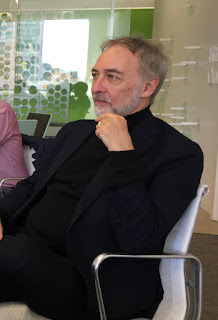 |
| Is street light conversion innovation? |
The Lantern Parade of the Creative Alliance that kicked things off, indeed, showed more creative use of LED lights than romantic candles one would initially associate with a lantern. But the artist's sculptures and creative light projections need a sound underpinning in the City's daily operations for an image of innovation to truly take hold. So is there lighting innovation in Baltimore beyond bathing prominent buildings in the colors of the Orioles and Ravens or accompany the Fourth of July fireworks with lasers that move in the rhythm of music?
The most extensive field for lighting innovation is, no doubt, the streetlight. Baltimore City alone has 70,000 of those, Baltimore County another 45,000. Across the world operators of street lights are in a race to convert those from the traditional high pressure sodium (yellow) or metal halide (white) heads to light emitting diodes (LED). The race is led by the lighting industry who can sell millions of new fixtures and lamps with the promise of savings of 40-50% over the old solutions, in part from energy conservation and in part from reduced maintenance due to longer lamp life.
Safety experts maintain that the white LED light is safer because of better color rendition; dark sky activists who fight light pollution welcome LED lighting because it has less spill and a more controlled field of lighting. But that same feature had Councilman Curran question if the new lights are really safer when one is near the edge of the field of lighting. Doctors warn that the more bluish LED light could further mess up people's circadian cycle, especially when the shine into bedrooms. In other words, the best street lighting is still evolving.
 |
| 1817 Baltimore gas light innovation |
Baltimore City has been no slouch when it comes to the simple "plug-out plug-in" conversion and has already changed out over 11,000 street lights and 37,000 bulbs in traffic signal heads. The pace of conversions seems to have slowed recently. In Baltimore only 10,000 of those street lights are owned by the City and the rest is owned by BGE which made for some bickering back in 2011 when the conversion first began. Baltimore City pays BGE for maintenance and wanted to take changing bulbs over to reap in the savings. BGE maintained that additional shut-off provisions would be needed to do this safely. The quarrel has been settled but sheds light less on innovation and more on bureaucracy.
The lighting industry has ramped up the promises with new ideas what the street lights could do: As we well know in Baltimore, street light poles can hold security cameras. They also could hold WiFi routers for free neighborhood internet and charging stations for electric vehicles (EV). Lights could be programmed to do more than come on and switch off. They could sense the presence of pedestrians, they could become brighter at times of unsavory activity, they could change light color (technical speak: light temperature) to influence the mood and, if hooked up with local solar panels, they could come off the grid as well. (Like Baltimore's parking kiosks who have their own solar panel on the slanted tops).
 |
| what is our image as an innovation hub? |
Given that this simple street light conversion happens everywhere. it hardly counts as innovation, even if it had a few EV chargers.
The changes that come from LED lighting can also be seen in corporate signs, in retail, on automobiles or on bicycles that become equipped with ever more powerful lighting not only for added visibility but also for an increasing cacophony of flashing lights on city streets and interstates. (As a study just proved, many of the new technology car headlights are really lousy).
As I said in my first blog about Light City Baltimore, information today is light, and light is information, considering fiber-optics, LED and laser as the leading technologies of both, lighting and information. And just as we are submerged by a ever larger flood of information, the revolution in lighting has already resulted in lights being everywhere and this is just the beginning.
 |
| CEO Henk Janssen, CEO Lightwell BV at Gensler's Baltimore office yesterday |
Now is the time to put the thinking-cap on to find out what true innovation in lighting would mean, so we are ready for next year's Light City Baltimore with a firmer grip on what the event should convey as its main message.
A good start would be the creation of some local jobs around LED fixture manufacturing. Conveniently, the CEO of Lightwell BV, a Dutch manufacturer came to Baltimore on board of the Clipper Stad Amsterdam which is currently docking at the West-Shore as part of a delegation from the Netherlands trying to promote Dutch industries. He is telling the Mayor today that he is looking for a manufacturing partner here in Baltimore.
Another step would be to further explore the connection between information and lighting for cities as part of the Smart Cities development. West Baltimore has recently been declared an Innovation Village. Let's see how lighting innovation can be harnessed there.
And while we are at it: the enhancement of the McKeldin Fountaun with light projections makes it really look good. How about an innovative permanent light solution for this fountain instead of demolition. Like the Exhale Plaza in Chapel Hill by Mikyoung Kim.
.Klaus Philipsen, FAIA
Links:
Brew article about street lighting conversion
Philips Lighting company LED lighting video
My Community Architect blog article How Technology Can Provide Access for Distressed Communities
.Klaus Philipsen, FAIA
Links:
Brew article about street lighting conversion
Philips Lighting company LED lighting video
My Community Architect blog article How Technology Can Provide Access for Distressed Communities
 |
| LED lighting and place-making: 140 West Plaza: Exhale, Chapel Hill, NC (photo Mikyoung Kim) |
No comments:
Post a Comment